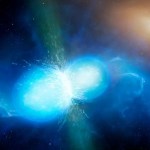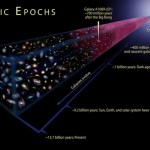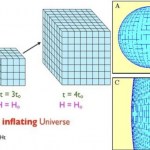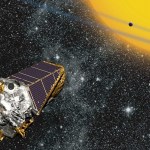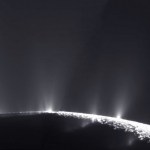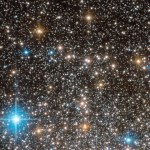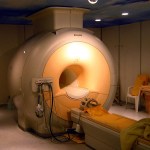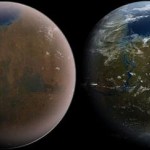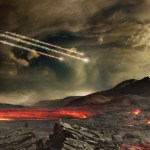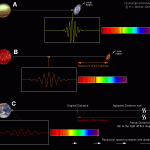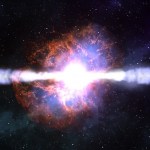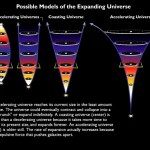ask Ethan
"Delay is the deadliest form of denial." -C. Northcote Parkinson
Every massless particle and wave travels at the speed of light when it moves through a vacuum. Over a distance of 130 million light years, the gamma rays and gravitational waves emitted by merging neutron stars arrived offset by a mere 1.7 seconds, an incredible result! Yet if the light was emitted at the same time as the merger, that 1.7 second delay shouldn’t be there, unless something funny is afoot.
In the final moments of merging, two neutron stars don't merely emit gravitational waves, but a catastrophic explosion that…
“Normal science, the activity in which most scientists inevitably spend almost all their time, is predicated on the assumption that the scientific community knows what the world is like.” -Thomas S. Kuhn
For all of human history, the biggest questions have fascinated us. Where did the Universe come from? How old is it? And what is its ultimate fate? Once relegated to the realm of theologians, poets, and philosophers, science has brought us closer than ever to the answers. But scientific revolutions have occurred before, in many cases significantly changing the answers to these and other…
“If the doors of perception were cleansed every thing would appear to man as it is, Infinite. For man has closed himself up, till he sees all things thro' narrow chinks of his cavern.” -William Blake
When it comes to the ultimate question of the size of the Universe, we have to look to greater scales than what we can possibly observe. Although we can place constraints on how big the unobservable Universe must be, coming up with a lower limit to its overall size, there’s a bigger question that we don’t yet know the answer to: is it finite in size, or is it truly infinite?
The observable…
"How vast those Orbs must be, and how inconsiderable this Earth, the Theatre upon which all our mighty Designs, all our Navigations, and all our Wars are transacted, is when compared to them." -Christiaan Huygens
With a field-of-view encompassing 150,000 stars, NASA’s Kepler mission delivered an overwhelming prize when it came to hunting worlds beyond our own Solar System: thousands of new exoplanets. The majority of them, however, were different from what we have at home. They were larger, more massive, closer to their parent stars, and orbiting more quickly than what we find in our own…
"Day after day, day after day,
We stuck, nor breath nor motion;
As idle as a painted ship
Upon a painted ocean.
Water, water, every where,
And all the boards did shrink;
Water, water, every where,
Nor any drop to drink."
- Samuel Taylor Coleridge
Here on Earth, water can easily exist in all three phases of matter: solid, liquid, and gas. The reason for this is simple: Earth has the right range of temperatures and pressures to experience not just the common solid and gas phases, but the liquid water phase, too. In the outer Solar System, worlds like Europa, Enceladus, and Pluto are too far…
“There’s something about sitting alone in the dark that reminds you how big the world really is, and how far apart we all are. The stars look like they’re so close, you could reach out and touch them. But you can’t. Sometimes things look a lot closer than they are.” -Kami Garcia
When we consider things like molecules, atoms, or even protons and neutrons, they all have finite, measurable sizes. Yet the fundamental particles that they’re made out of, like quarks, electrons, and gluons, are all inherently points, with no physical size to them at all. Why, then, does every composite particle not…
"We have to understand the ubiquity of energy in everything we do. Energy is core to our economy and it brings with it environmental challenges, and it's core to our security challenges." -Ernest Moniz
In 1953, then-President Eisenhower, in the aftermath of World War II and with rising tensions between the USA and the Soviet Union resulting in a nuclear arms race, began the “Atoms For Peace” plan. The idea was that all nations should be able to reap the benefits of nuclear power, while simultaneously keeping the world safe from nuclear war. While the same ingredients can be used for both…
"Comrades, this man has a nice smile, but he's got iron teeth." -Andrei A. Gromyko
When you have a star, perhaps its most defining characteristic is that it fuses lighter elements into heavier ones, releasing energy. While all stars fuse hydrogen into helium, the more massive ones will undergo helium fusion, with the most massive also fusing carbon, oxygen, and eventually silicon, producing iron in the end. By time you get to iron, the most stable element of all, you would lose energy if you fused anything further, so iron’s the end-of-the-road, with a supernova as the next inevitable step.…
"Imagination makes us aware of limitless possibilities. How many of us haven't pondered the concept of infinity or imagined the possibility of time travel? In one of her poems, Emily Bronte likens imagination to a constant companion, but I prefer to think of it as a built-in entertainment system." -Alexandra Adornetto
The dream of futuristic technologies and what they might enable us to do -- travel back in time, create artificial gravity, traverse the stars, create unlimited energy -- are some of the best goals science can aspire to. While a great many of the technologies we’ve envisioned…
"In the future, maybe quantum mechanics will teach us something equally chilling about exactly how we exist from moment to moment of what we like to think of as time." -Richard K. Morgan
It’s absolutely true that, in quantum mechanics, there are certain pairs of properties that we simply can’t measure simultaneously. Measure the position of an object really well, and its momentum becomes more uncertain. Measure its energy, and its time becomes more uncertain. And measure its voltage, and the free charge becomes more uncertain. Although this is disconcerting to some, it’s a fundamental part of…
"Chlorine is a deadly poison gas employed on European battlefields in World War I. Sodium is a corrosive metal which burns upon contact with water. Together they make a placid and unpoisonous material, table salt. Why each of these substances has the properties it does is a subject called chemistry." -Carl Sagan
Every beginning chemistry student learns what happens when you put a chunk of sodium metal into water: you get an extremely violent reaction out. The sodium and water bubble and fizz, and sometimes even a flame or an outright combustion reaction is produced. This isn’t exclusive to…
"There was a young lady named Bright,
Whose speed was far faster than light;
She set out one day
In a relative way,
And returned on the previous night." -A.H. Reginald Butler
Throughout the entire Universe, there’s a fundamental law that governs the motions of all particles: Einstein’s relativity. It states that all particles with mass can never attain the speed of light, no matter how much energy you put into it. Additionally, all massless particles only move at the speed of light, no matter what you do to either them or to the device/person observing them. No matter what reference frame you…
"Weakness of character is the only defect which cannot be amended." -Francois de La Rochefoucauld
So, you’d like to ruin the fabric of your space, would you? Similar to tying a knot in it, stitching it up with some poorly-run shenanigans, running a two-dimensional membrane through it (like a hole in a sponge), etc., it’s possible to put a topological defect in the fabric of space itself. This isn’t just a mathematical possibility, but a physical one: if you break a symmetry in just the right way, monopoles, strings, domain walls, or textures could be produced on a cosmic scale.
The…
"It would be great some day to have astronauts in a rover on Mars. But just about anyone except an oil company executive would say its more important to have 50 million solar powered vehicles in the United States." -Brad Sherman
Is terraforming a real possibility for Mars? It seems like one of the most inhospitable places we could have asked for: cold, small, barren, devoid of liquid water, with only a thin atmosphere, and with soil that’s toxic to terrestrial lifeforms. Yet Mars was once a wet, thriving planet, teeming with all the potential for life that an early Earth once possessed.
A…
"I would argue that in any habitable zone that doesn't boil or freeze, intelligent life is going to emerge because intelligence is convergent." -Simon Conway Morris
Someday, in the far distant future, the evolution of the Sun will cause it to heat up and emit so much energy that the Earth’s surface will reach a terrible threshold: 100 degrees Celsius (212 degrees Fahrenheit). When this happens, the oceans will boil away, rendering the surface completely uninhabitable and inhospitable to even the most extreme known forms of life.
If we do nothing to prevent it, then at some point over the…
"In expanding the field of knowledge we but increase the horizon of ignorance." -Henry Miller
You know it as the most fundamental law of relativity: that nothing can travel faster than the speed of light. And yet, the observable Universe itself, which has been around for 13.8 billion years since the Big Bang, is now 46.1 billion light years in radius. If everything were contracted down to a tiny volume of space, it seems that such a size would be impossible to achieve. Unless, somehow, space itself were expanding faster than the speed of light.
The Hercules galaxy cluster showcases a great…
"Black holes are the seductive dragons of the universe, outwardly quiescent yet violent at the heart, uncanny, hostile, primeval, emitting a negative radiance that draws all toward them, gobbling up all who come too close…these strange galactic monsters, for whom creation is destruction, death life, chaos order." -Robert Coover
For the third time since it began taking data, the LIGO collaboration discovered direct evidence for merging black holes in the Universe. There's an incredible amount we've learned about black holes and where they're located, however, and very little of it comes from…
"The Edge... there is no honest way to explain it because the only people who really know where it is are the ones who have gone over." -Hunter S. Thompson
When we look at the nearby Universe, it looks a lot like we, ourselves, appear. Nearby galaxies are similar in structure to our own; the stars inside them have the same properties, masses, ages and distributions as our own. But as we look to greater and greater cosmic distances, we find that more distant galaxies appear younger, bluer, smaller, and less evolved. If we go back beyond a certain point, there are no more galaxies at all.…
"It's everywhere, really. It's between the galaxies. It is in this room. We believe that everywhere that you have space, empty space, that you cannot avoid having some of this dark energy." -Adam Riess
Have you heard about the accelerating Universe? What about dark energy, vacuum energy, or a cosmological constant? These are terms we throw around to talk about one of the strangest observations ever made in the Universe: that the more distant a galaxy is from us, the faster it appears to be receding from us. Not only that, but the rate of recession appears to actually increase over time, which…
“Despite its name, the big bang theory is not really a theory of a bang at all. It is really only a theory of the aftermath of a bang.” -Alan Guth
When we look to the deepest reaches of space, we can look for the “first” of any type of object. The first galaxy, the first star, the first light from the CMB, or even the first signals from the Big Bang, like gravitational waves. Yet these signals all have very different redshifts from one another, and perhaps more puzzlingly, lie at extraordinarily different cosmic distances from us.
Looking towards the north pole of the Milky Way galaxy, we…
